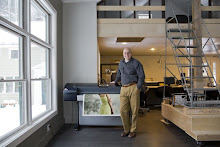We were honored to print approximately fifty prints for this two-year traveling exhibition of original international art with an environmental theme. From the Website of the exhibition (with thanks to Kalman Gacs, Curator):
These artworks have been chosen to represent a variety of approaches to thinking about our relationship to the environment and its preservation. Bill McKibben, founder of an international environmentalist movement called 350.org, wrote an essay entitled “What the warming world needs now is art, sweet art.” As McKibben has acknowledged, visual artists are now approaching environmental issues in a variety of powerful ways. Some of their works are disturbing, while others are comedic or awe inspiring. Some work to persuade the audience through reason, while some are wild expressions of passion and exploration, more the stuff of dreams and madness. Both approaches have resulted in artworks that scream out of their frames.
Wednesday, December 30, 2009
Monday, December 7, 2009
The Shipping Dilemma
Shipping artwork is fraught with perils... damaged work, crushed packages, dog-eared corners, weather effects and packages that just seem to disappear into thin air. Green shipping options are hard to come by and the very nature of shipping itself is energy intensive. 747s, for example, burn about a gallon of fuel for every second in flight and slightly less when sitting on the runway.
There’s a lot of “virgin” packaging used in shipping and most of it is made from tree-based paper products such as corrugate. Recycled containers are available including mailing tubes and boxes but they often carry a premium over virgin materials that most people don’t seem willing to pay. The result is that more than 40 percent of landfill content nationwide is paper.
I just had a client call to tell me that the 30x40 print we made for him was ruined by a crushed “cheap” mailing tube he used to send it to his brother. This isn’t an unusual story. Preserving art in shipment is an art in and of itself. Larger pieces are particularly vulnerable and often require specialized packaging including custom-made crates and reinforced or structurally sound tubes. Sometimes you just have to use something like this in order to protect the contents.
These are a dozen the things we do to ensure safe and green shipping:
There’s a lot of “virgin” packaging used in shipping and most of it is made from tree-based paper products such as corrugate. Recycled containers are available including mailing tubes and boxes but they often carry a premium over virgin materials that most people don’t seem willing to pay. The result is that more than 40 percent of landfill content nationwide is paper.
I just had a client call to tell me that the 30x40 print we made for him was ruined by a crushed “cheap” mailing tube he used to send it to his brother. This isn’t an unusual story. Preserving art in shipment is an art in and of itself. Larger pieces are particularly vulnerable and often require specialized packaging including custom-made crates and reinforced or structurally sound tubes. Sometimes you just have to use something like this in order to protect the contents.
These are a dozen the things we do to ensure safe and green shipping:
- Use recycled packaging content whenever possible.
- Reuse, reuse, reuse. Send out durable packaging with a prepaid return label and use it again and again. Even “virgin” materials can be more green if they’re reused.
- Make everything in your packaging recyclable and accept it back for recycling if the recipient doesn’t know where or how to get it safely recycled.
- Avoid potentially toxic packaging materials that might wind up in the waste stream.
- Use what you have on hand. For instance, we often ship using the recycled cores from paper rolls, which are stronger and more durable than virgin tubes.
- We have a set of PVC tubes with end caps that we use when absolutely necessary in sending rolled prints. PVC? “You have to be kidding,” you’re probably saying. Could there be a worse material? Well, every time we send one of these we include a return, prepaid label and we insist on getting the tubes back for use again. We have yet to have a client refuse. You can do the same with other durable materials.
- While we’re happy to provide green mounting and framing we often suggest that clients do this locally. Shipping framed art almost always requires extensive packaging including custom-made crates tailored to the content. It also requires plexi rather than glass (which is almost impossible to ship safely).
- Take a look at your carrier’s environmental record and choose the one you think is most environmentally responsible. (http://www.sustainability.ups.com/environment/index.html is UPS’s green information site.)
- Just say “no” to shipping. When you can use email instead of printed communications do so. Don’t buy prints unless you need them.
- Learn to softproof so you can minimize printing and shipping of proofs and still know what your images will look like.
- Calibrate your monitor - the first step in a reliable soft proofing workflow.
- It may sound counterintuitive, but having your shipped goods picked up can actually save fuel if you’re in a well served area with UPS/FedEx/USPS trucks around anyway. If not, driving to the nearest shipping location or drop box is probably the best bet.
Subscribe to:
Posts (Atom)






